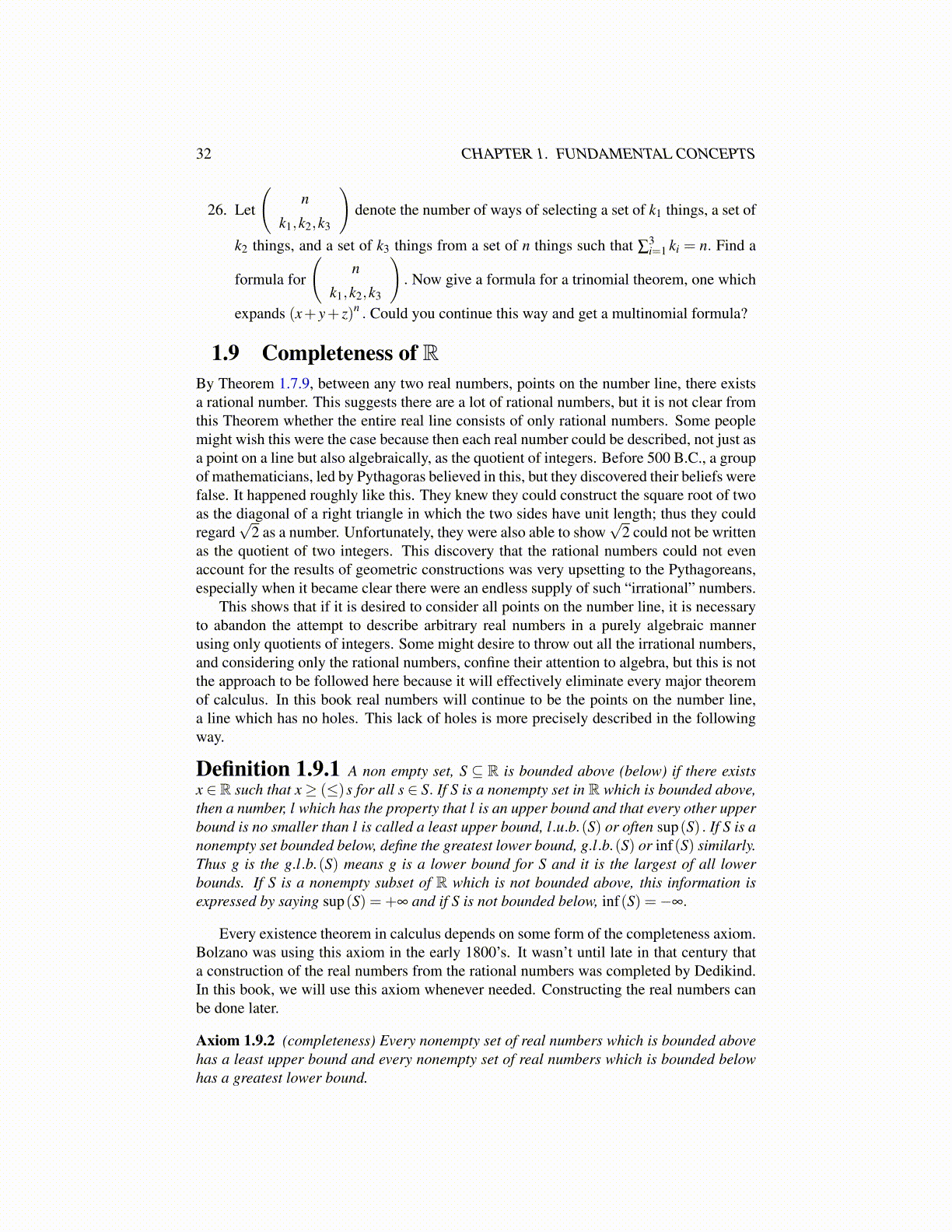
32 CHAPTER 1. FUNDAMENTAL CONCEPTS
26. Let
(n
k1,k2,k3
)denote the number of ways of selecting a set of k1 things, a set of
k2 things, and a set of k3 things from a set of n things such that ∑3i=1 ki = n. Find a
formula for
(n
k1,k2,k3
). Now give a formula for a trinomial theorem, one which
expands (x+ y+ z)n . Could you continue this way and get a multinomial formula?
1.9 Completeness of RBy Theorem 1.7.9, between any two real numbers, points on the number line, there existsa rational number. This suggests there are a lot of rational numbers, but it is not clear fromthis Theorem whether the entire real line consists of only rational numbers. Some peoplemight wish this were the case because then each real number could be described, not just asa point on a line but also algebraically, as the quotient of integers. Before 500 B.C., a groupof mathematicians, led by Pythagoras believed in this, but they discovered their beliefs werefalse. It happened roughly like this. They knew they could construct the square root of twoas the diagonal of a right triangle in which the two sides have unit length; thus they couldregard
√2 as a number. Unfortunately, they were also able to show
√2 could not be written
as the quotient of two integers. This discovery that the rational numbers could not evenaccount for the results of geometric constructions was very upsetting to the Pythagoreans,especially when it became clear there were an endless supply of such “irrational” numbers.
This shows that if it is desired to consider all points on the number line, it is necessaryto abandon the attempt to describe arbitrary real numbers in a purely algebraic mannerusing only quotients of integers. Some might desire to throw out all the irrational numbers,and considering only the rational numbers, confine their attention to algebra, but this is notthe approach to be followed here because it will effectively eliminate every major theoremof calculus. In this book real numbers will continue to be the points on the number line,a line which has no holes. This lack of holes is more precisely described in the followingway.
Definition 1.9.1 A non empty set, S ⊆ R is bounded above (below) if there existsx ∈R such that x ≥ (≤)s for all s ∈ S. If S is a nonempty set in R which is bounded above,then a number, l which has the property that l is an upper bound and that every other upperbound is no smaller than l is called a least upper bound, l.u.b.(S) or often sup(S) . If S is anonempty set bounded below, define the greatest lower bound, g.l.b.(S) or inf(S) similarly.Thus g is the g.l.b.(S) means g is a lower bound for S and it is the largest of all lowerbounds. If S is a nonempty subset of R which is not bounded above, this information isexpressed by saying sup(S) = +∞ and if S is not bounded below, inf(S) =−∞.
Every existence theorem in calculus depends on some form of the completeness axiom.Bolzano was using this axiom in the early 1800’s. It wasn’t until late in that century thata construction of the real numbers from the rational numbers was completed by Dedikind.In this book, we will use this axiom whenever needed. Constructing the real numbers canbe done later.
Axiom 1.9.2 (completeness) Every nonempty set of real numbers which is bounded abovehas a least upper bound and every nonempty set of real numbers which is bounded belowhas a greatest lower bound.